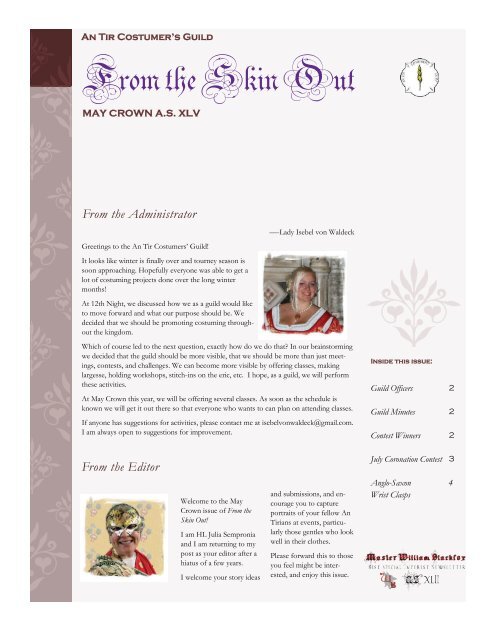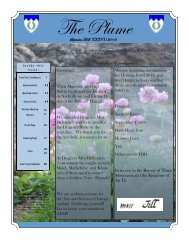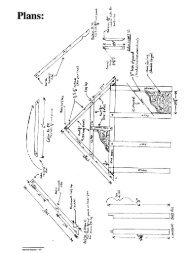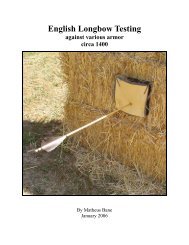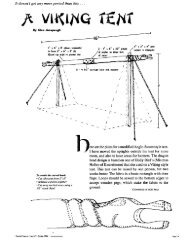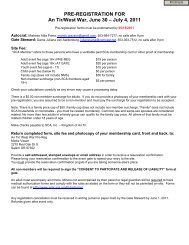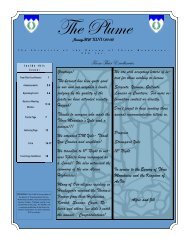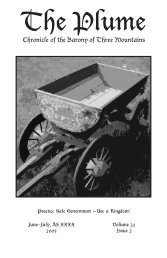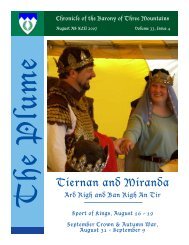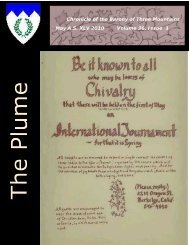From the Administrator From the Editor - the Current Middle Ages
From the Administrator From the Editor - the Current Middle Ages
From the Administrator From the Editor - the Current Middle Ages
Create successful ePaper yourself
Turn your PDF publications into a flip-book with our unique Google optimized e-Paper software.
An Tir Costumer’s Guild<br />
<strong>From</strong> <strong>the</strong> Skin Out<br />
MAY CROWN A.S. XLV<br />
<strong>From</strong> <strong>the</strong> <strong>Administrator</strong><br />
Greetings to <strong>the</strong> An Tir Costumers’ Guild!<br />
It looks like winter is finally over and tourney season is<br />
soon approaching. Hopefully everyone was able to get a<br />
lot of costuming projects done over <strong>the</strong> long winter<br />
months!<br />
At 12th Night, we discussed how we as a guild would like<br />
to move forward and what our purpose should be. We<br />
decided that we should be promoting costuming throughout<br />
<strong>the</strong> kingdom.<br />
—-Lady Isebel von Waldeck<br />
Which of course led to <strong>the</strong> next question, exactly how do we do that? In our brainstorming<br />
we decided that <strong>the</strong> guild should be more visible, that we should be more than just meetings,<br />
contests, and challenges. We can become more visible by offering classes, making<br />
largesse, holding workshops, stitch-ins on <strong>the</strong> eric, etc. I hope, as a guild, we will perform<br />
<strong>the</strong>se activities.<br />
At May Crown this year, we will be offering several classes. As soon as <strong>the</strong> schedule is<br />
known we will get it out <strong>the</strong>re so that everyone who wants to can plan on attending classes.<br />
If anyone has suggestions for activities, please contact me at isebelvonwaldeck@gmail.com.<br />
I am always open to suggestions for improvement.<br />
Inside this issue:<br />
Guild Officers 2<br />
Guild Minutes 2<br />
Contest Winners 2<br />
<strong>From</strong> <strong>the</strong> <strong>Editor</strong><br />
July Coronation Contest 3<br />
Welcome to <strong>the</strong> May<br />
Crown issue of <strong>From</strong> <strong>the</strong><br />
Skin Out!<br />
I am HL Julia Sempronia<br />
and I am returning to my<br />
post as your editor after a<br />
hiatus of a few years.<br />
I welcome your story ideas<br />
and submissions, and encourage<br />
you to capture<br />
portraits of your fellow An<br />
Tirians at events, particularly<br />
those gentles who look<br />
well in <strong>the</strong>ir clo<strong>the</strong>s.<br />
Please forward this to those<br />
you feel might be interested,<br />
and enjoy this issue.<br />
Anglo-Saxon<br />
Wrist Clasps<br />
4
FROM THE SKIN OUT<br />
Page 2<br />
Guild Officers<br />
<strong>Administrator</strong><br />
Lady Isebel von Waldeck<br />
isebelvonWaldeck@gmail.com<br />
Deputy to <strong>the</strong><br />
<strong>Administrator</strong><br />
(Accepting Applications)<br />
isebelvonWaldeck@gmail.com<br />
Textile Sub-Guild<br />
<strong>Administrator</strong><br />
(Accepting Applications)<br />
isebelvonWaldeck@gmail.com<br />
Contest Coordinator<br />
Ma<strong>the</strong>a Volpella da Perusia<br />
ladyma<strong>the</strong>a@gmail.com<br />
Deputy to <strong>the</strong> Contest<br />
Coordinator<br />
Mistress Isolde de la Vielle-a-Rose<br />
isolde@ibix.net<br />
Education/<br />
Challenges<br />
Coordinator<br />
HL Annaka Poznanska<br />
alphamike99@yahoo.com<br />
Exchequer<br />
HL Ka<strong>the</strong>ryn de Gonneville<br />
ka<strong>the</strong>ryn98501@yahoo.com<br />
Deputy to <strong>the</strong><br />
Exchequer<br />
(Accepting Applications)<br />
isebelvonWaldeck@gmail.com<br />
Webmaster<br />
Sabine d'Angers, JdL<br />
sabine@sirencreations.com<br />
Activities<br />
Coordinator<br />
HL Elewys Finchingefeld<br />
klos<strong>the</strong>ller@verizon.net<br />
12th Night Guild Meeting Minutes<br />
Thanks to everyone who participated<br />
in <strong>the</strong> Costumers’ Guild<br />
meeting this past 12th Night.<br />
There was AMAZING energy<br />
and really great ideas!<br />
What is <strong>the</strong> Mission of <strong>the</strong> Costumers’<br />
Guild?<br />
<strong>Current</strong> Goals<br />
1. Make <strong>the</strong> Costumers’ Guild<br />
more meaningful to selves<br />
and <strong>the</strong> kingdom<br />
2. Change image from stuffy<br />
to relevant<br />
3. Everyone needs a costume<br />
to play!<br />
4. Dispel myths<br />
5. Personal outreach (e.g.,<br />
hallway conversations, hand<br />
out gilded lilies)<br />
Officers<br />
Contest Coordinator:<br />
Lady Ma<strong>the</strong>a Volpella da Perusia<br />
Education/Challenges Coordinator:<br />
HL Annaka Poznanska<br />
Activities Coordinator:<br />
HL Elewys Finchingefeld<br />
Newsletter <strong>Editor</strong>:<br />
HL Julia Sempronia<br />
Website Updates<br />
The following sections are going<br />
through a overhaul:<br />
Officers<br />
Newsletters:<br />
Going forward, all future FTSOs<br />
will be published on <strong>the</strong> Kingdom<br />
Costumers’ Guild website,<br />
www.currentmiddleages.org/<br />
Costumers<br />
We will no longer be mailing out<br />
physical copies. We will also be<br />
making all back issues available<br />
online.<br />
Challenges<br />
Helpful links<br />
Annotated Bibliography<br />
Book Reviews<br />
Movie views & reviews (list<br />
from Mattea)<br />
Commercial pattern review<br />
(Mattea)<br />
Actions<br />
Need new Costumers’ Guild<br />
banners - need volunteers (or<br />
add to activities list?)<br />
Reignite interest in <strong>the</strong> Weavers’<br />
Sub-Guild?<br />
Need Activities Coordinator<br />
Activities Brainstorm<br />
• Make largesse like hats,<br />
coifs, veils, pouches,bags,<br />
handspun yarn, felt, tassels,<br />
fingerloop braid / lucet<br />
braid, book covers<br />
• Extreme costuming<br />
• Garb for royals<br />
• Children’s / adult clothing<br />
exchange<br />
• Fabric white elephant<br />
• Costuming laurels’ first<br />
garb display<br />
• Classes before & after<br />
meeting to attract more<br />
people to <strong>the</strong> meeting (lowcost<br />
or free)<br />
Class Ideas<br />
1. Practical<br />
2. Hoods<br />
3. Belt Purses<br />
4. Mongolian Hats<br />
5. Costume Clinic (New Tunic<br />
- Measure Hem); Help Fitting<br />
(like office hours)<br />
6. Overview of Place & Time<br />
7. How to Fit a Sleeve<br />
8. Fingerloop Braid Class<br />
(really fun if it’s big); also a<br />
good ice breaker<br />
Newsletter <strong>Editor</strong><br />
HL Julia Sempronia, JdL<br />
julilla@lady.sca.org<br />
PR Officer<br />
Agnes Berengarii de Girona<br />
agnesberengarii@dolan-viney.com<br />
PR Deputy<br />
Abrahe çaragoça<br />
abrahecaragoca@dolan-viney.com<br />
This is <strong>the</strong> May 2010 version of <strong>From</strong> <strong>the</strong> Skin Out, a quarterly publication of <strong>the</strong> Costumer’s<br />
Guild, a chartered Arts guild of <strong>the</strong> Kingdom of An Tir. Issues are published for 12th Night, May<br />
Crown, July Coronation and September Crown. Electronic copies are available at http://<br />
www.currentmiddleages.org/costumers/<br />
FTSO is not a corporate publication of SCA, Inc., and does not delineate SCA, Inc. policies.<br />
Copyright © 2010 Society for Creative Anachronism, Inc. For information on reprinting photographs,<br />
articles, or artwork from this publication, please contact <strong>the</strong> editor, who will assist you in<br />
contacting <strong>the</strong> original creator of <strong>the</strong> piece. Please respect <strong>the</strong> legal rights of our contributors.
Page 3<br />
MAY CROWN A. S. XLV<br />
12th Night Full Court Garb Competition<br />
— HL Raffaella di Contino<br />
Winner Sebastian von Aterdorff<br />
& Contest Coordinator<br />
Without fur<strong>the</strong>r ado, here are <strong>the</strong><br />
winners from this year’s 12th<br />
Night Full Court Garb Competition<br />
NOVICE 1ST PLACE:<br />
SEBASTIAN VON ATER-<br />
DORFF<br />
His late period outfit was literally<br />
breathtaking! When he came to<br />
sign up I was completely astounded<br />
that he had been costuming<br />
for less than a year!<br />
Brava!<br />
NOVICE 2ND PLACE:<br />
RUADHAN O FEARAIN<br />
(AKA HL Ferain, please forgive<br />
<strong>the</strong> lack of many accent marks)<br />
who made himself a fantastic<br />
Tudor outfit.<br />
INTERMEDIATE 1ST<br />
PLACE: SOELIG SWEET-<br />
GLEE<br />
Made an amazing <strong>Middle</strong> Byzantine<br />
(ca. 1075 A.D.) ensemble<br />
that she made for Baron Hauk of<br />
Aquaterra. If you didn’t get to<br />
see this it’s nearly blinding in its<br />
brilliance. So much gorgeous<br />
embellishment.<br />
INTERMEDIATE 2ND<br />
PLACE:<br />
EULALIA DE RAVENFELD<br />
Presented a complete 14th c.<br />
English outfit from <strong>the</strong> head<br />
wear to <strong>the</strong> handmade turn<br />
shoes, and from her undies to<br />
her outerwear. Huzzah!<br />
ADVANCED 1ST PLACE:<br />
MIYAMOTO NO AKIK-<br />
ONMU<br />
Presented a complete 16th c.<br />
Japanese ensemble also from <strong>the</strong><br />
skin out!<br />
ADVANCED 2ND PLACE:<br />
KARYN GEORGSDOTTIR<br />
Made a mid-14th cent. Icelandic<br />
outfit, both lovely and functional!<br />
This year we did something completely<br />
new for prizes, and we had<br />
charters designed by Annaka<br />
Poznanska specifically for us. This<br />
was a great addition and I hope all<br />
<strong>the</strong> recipients were delighted by<br />
<strong>the</strong>ir award scrolls.<br />
Huzzah to all those who entered,<br />
and those who judged for work<br />
well done! You have made my<br />
experience as Contest Coordinator<br />
a rich and rewarding one!<br />
Soelig Sweetglee<br />
July Coronation Tourney Garb Contest<br />
— HL Ma<strong>the</strong>a da Perusia<br />
The An Tir Costumers' Guild is<br />
once again proud to sponsor its<br />
yearly Tourney Garb Competition<br />
at July Coronation.<br />
"Tourney Garb" means garb<br />
which is appropriate for your<br />
persona and which is durable and<br />
practical enough to withstand<br />
being worn at an S.C.A. camping<br />
event in An Tir. The costume<br />
entered can be for your regular<br />
persona or for any alternate persona<br />
you choose.<br />
There are four (4) separate categories<br />
at each competition:<br />
NOVICE, INTERMEDIATE,<br />
ADVANCED and EXPERT.<br />
The criteria for <strong>the</strong>se categories<br />
are listed on <strong>the</strong> guild website:www.currentmiddleages.org/<br />
costumers/<br />
You do not need to be a member<br />
of <strong>the</strong> Costumers' Guild in order<br />
to enter—contests are open to<br />
everyone.<br />
The only person who can enter<br />
<strong>the</strong> costume is <strong>the</strong> person who<br />
made <strong>the</strong> costume. You can enter<br />
a costume you made for someone<br />
else, and have that person<br />
model <strong>the</strong> costume, but <strong>the</strong><br />
maker must be <strong>the</strong> actual entrant.<br />
The costume is always judged<br />
"on <strong>the</strong> body" (not on a hanger).<br />
It doesn't have to be on your<br />
body, but it does have to be on<br />
someone's body.<br />
Both of <strong>the</strong> current contests are<br />
for complete costumes, including<br />
headwear, footwear and undergarments.<br />
You will be allowed to<br />
enter a costume that is lacking<br />
some of <strong>the</strong>se elements, but you<br />
may well be judged against people<br />
whose costume is more complete,<br />
which will give <strong>the</strong>m an<br />
advantage. Documentation is<br />
strongly recommended, but not<br />
required. You may enter <strong>the</strong> contest<br />
without documentation, but<br />
you might be judged against people<br />
who do have documentation.<br />
Advance registration is recommended.<br />
We assign a 20 minute<br />
time slot to each contestant.<br />
If you wait until <strong>the</strong> last minute<br />
to enter, you may get stuck at <strong>the</strong><br />
end of <strong>the</strong> day and sometimes we<br />
even run out of time and have to<br />
turn contestants away, so try to<br />
register early.<br />
You can pre-register by contact-<br />
ing HL Ma<strong>the</strong>a da Perusia, ladyma<strong>the</strong>a@gmail.com,<br />
or by arriving<br />
at <strong>the</strong> contest early and signing up<br />
on <strong>the</strong> sign-in sheet which is always<br />
provided. You can obtain an<br />
electronic copy of <strong>the</strong> Judging<br />
Form used in <strong>the</strong> contests by<br />
emailing me or by picking one up<br />
in person at an event where a contest<br />
is being held. This will allow<br />
you to consider in advance <strong>the</strong><br />
elements you will be judged on<br />
and <strong>the</strong> weight given each one.
FROM THE SKIN OUT<br />
Page 4<br />
Feature Article: Anglo-Saxon Wrist Clasps<br />
—HL Annaka Poznanska, JdL<br />
What Was Done in Period<br />
The wrist clasp<br />
performed a useful<br />
and decorative<br />
function, providing a<br />
closure for a tightfitting<br />
sleeve.<br />
The Anglo-Saxons were a Germanic<br />
people who invaded England<br />
in <strong>the</strong> 5th century and ruled<br />
until <strong>the</strong> Norman Conquest in<br />
1066. Much of our knowledge of<br />
Anglo-Saxon people comes<br />
from settlement excavations and<br />
grave goods. Large Anglo-Saxon<br />
cemeteries and numerous individual<br />
burials in <strong>the</strong> North and<br />
East of England have been excavated<br />
and extensively studied.<br />
Amateur enthusiasts have also<br />
discovered a plethora of Anglo-<br />
Saxon artifacts with metal detectors.<br />
During <strong>the</strong> pre-Christian era,<br />
Anglo-Saxons were typically<br />
buried with a variety of personal<br />
possessions including jewelry,<br />
domestic tools and containers,<br />
and weapons. As Pagans, <strong>the</strong><br />
Anglo-Saxons might have believed<br />
<strong>the</strong>se objects would be<br />
useful in <strong>the</strong> afterlife.<br />
The Anglo-Saxons were skilled<br />
metal smiths, and produced a<br />
wide variety of jewelry and decorative<br />
items in gold, silver, copper,<br />
bronze, and brass. Metal<br />
jewelry found in Anglo-Saxon<br />
women’s graves commonly includes<br />
wrist clasps, brooches,<br />
and pendants.<br />
Wrist Clasps - Fashion<br />
and Function<br />
The fashion of wearing wrist<br />
clasps may have come to England<br />
from Scandinavia, and appeared<br />
around 470. Wrist clasps<br />
seem to have gone out of fashion<br />
in <strong>the</strong> 7th century, even<br />
though tight-fitting sleeves ap-<br />
pear in Anglo-<br />
Saxon art well<br />
past that time.<br />
Many different<br />
styles of wrist<br />
clasps were produced<br />
during <strong>the</strong><br />
5th and 6th centuries.<br />
The wrist<br />
clasp sets in <strong>the</strong><br />
following illustration<br />
are made of<br />
bronze and were<br />
all recovered<br />
from <strong>the</strong> Norton<br />
cemetery site.<br />
The wrist clasp performed a<br />
useful and decorative function,<br />
providing a closure for a tightfitting<br />
sleeve. No more than one<br />
set of clasps has ever been found<br />
in a single grave, yielding <strong>the</strong><br />
conclusion that only one layer of<br />
clothing was fastened in this<br />
method. Because wrist clasps are<br />
found more frequently in graves<br />
with o<strong>the</strong>r jewelry and possessions<br />
that indicate <strong>the</strong> deceased<br />
woman was at least moderately<br />
well to do, wrist clasps may have<br />
been a status symbol or only<br />
worn on one’s best clothing.<br />
Wrist clasps were sewn onto <strong>the</strong><br />
garment – no traces of rivets<br />
have been found.<br />
Wrist clasps often preserve fragments<br />
of tablet-woven trim or<br />
lea<strong>the</strong>r that is exactly <strong>the</strong> same<br />
width as <strong>the</strong> clasp. This indicates<br />
to me that <strong>the</strong> clasp and <strong>the</strong><br />
sleeve trim were probably made<br />
to go with each o<strong>the</strong>r.<br />
Wrist clasps are often found as a<br />
matched set (same style on both<br />
sleeves). Some graves yielded<br />
two different styles of clasp, one<br />
on a right and <strong>the</strong> o<strong>the</strong>r on a left<br />
sleeve. In o<strong>the</strong>r graves, only one<br />
clasp set was found on <strong>the</strong> left<br />
side, and a bead appeared to be<br />
used as a button to close <strong>the</strong><br />
right sleeve. Occasionally, <strong>the</strong><br />
clasps are not matched, as in <strong>the</strong><br />
lower left example from <strong>the</strong><br />
Norton site. Mis-matched sets<br />
also come from graves that have<br />
been previously disturbed. This<br />
is a more likely occurrence if<br />
found by an amateur collector<br />
with a metal detector in farmer’s<br />
field. To <strong>the</strong> right is ano<strong>the</strong>r<br />
example of such a set, described<br />
as being from two different garments.<br />
Although in reality, this<br />
assessment may not be true.<br />
(Continued on page 5)
FROM THE SKIN OUT<br />
Page 5<br />
Manufacture and Decorative Elements<br />
(Continued from page 4)<br />
Common decoration patterns<br />
stamped onto wrist clasps are<br />
<strong>the</strong> familiar Anglo-Saxon forms<br />
of dots, concentric rings, straight<br />
lines or bars, and raised halfdomes,<br />
such as we see on annular<br />
brooches and pendants from<br />
<strong>the</strong> same time period. The following<br />
illustration shows <strong>the</strong> full<br />
range of Anglo-Saxon forms<br />
present on artifacts found at<br />
Norton.<br />
Wrist clasps were ei<strong>the</strong>r cast or<br />
made from a sheet of metal.<br />
Here are several recently found<br />
examples of wrist clasps from<br />
<strong>the</strong> UK Detector Finds database.<br />
The first two are cast pieces. The<br />
third is an example of a repousee<br />
piece. Only one half of each of<br />
<strong>the</strong> clasps was recovered.<br />
Description: An early Anglo-<br />
Saxon cast copper-alloy wrist or<br />
sleeve clasp with a central hook<br />
on <strong>the</strong> back. The front of <strong>the</strong><br />
clasp has a ridge across <strong>the</strong> entire<br />
width at <strong>the</strong> hooked end,<br />
and four molded roundels in a<br />
line at <strong>the</strong> attachment end. The<br />
ridge is decorated with transverse<br />
grooves, and <strong>the</strong> roundels<br />
each have an indented central<br />
quatrefoil. Incised triple lines<br />
link <strong>the</strong> roundels, and between<br />
<strong>the</strong> outer pair on each side, <strong>the</strong>re<br />
is a protruding loop for stitching<br />
<strong>the</strong> clasp to a garment. There are<br />
traces of silvering or tinning on<br />
<strong>the</strong> surface.<br />
Size (mm): 43mm x 14mm<br />
Date Range: Late 5th - 6th century<br />
AD<br />
Findspot: Near Horncastle<br />
County: Lincolnshire<br />
Description: An early Anglo-<br />
Saxon cast copper-alloy wrist or<br />
sleeve clasp. It has a serrated<br />
outer edge, three attachment<br />
holes and a rectangular loop of<br />
reduced thickness for <strong>the</strong> clasp<br />
hook. The front has incised<br />
linear decoration, including two<br />
saltires and border lines along<br />
<strong>the</strong> serrated edge and sides.<br />
Size (mm):<br />
16mm<br />
30mm x<br />
Date Range: Late 5th -<br />
6th century AD<br />
Findspot: North Cave<br />
County: Yorkshire<br />
A copper-alloy wrist clasp of <strong>the</strong><br />
early Anglo-Saxon period. It is<br />
made from sheet bronze and has<br />
two stitching holes on one side<br />
and<br />
an integral central hook on <strong>the</strong><br />
o<strong>the</strong>r. The central field is decorated<br />
with three domes of repoussé form,<br />
<strong>the</strong> periphery with punched annulets.<br />
Size (mm):<br />
Date Range:<br />
century AD<br />
28mm<br />
Late 5th - 6th<br />
Findspot: Aldbourgh<br />
County: Yorkshire/north<br />
What I Did – A Method of Reconstruction<br />
The wrist clasp set that I made<br />
was an attempt to partially recreate<br />
one of <strong>the</strong> clasps found at <strong>the</strong><br />
Norton site, using <strong>the</strong> repousse<br />
method on sheet brass. The artifact<br />
I reproduced is described as<br />
being made of a copper alloy.<br />
This copper alloy could be ei<strong>the</strong>r<br />
brass or bronze. Brass and<br />
bronze are both period materials<br />
for Anglo-Saxon metal smiths.<br />
Brass is an alloy of copper and<br />
zinc. Bronze is an alloy of copper<br />
and tin. I chose brass sheet because<br />
it is readily available at<br />
local hobby shops and is relatively<br />
inexpensive. Bronze sheet<br />
is about 5 times <strong>the</strong> price of<br />
brass sheet and has to be ordered<br />
online. So due to <strong>the</strong> price and<br />
availability, I decided to use<br />
brass.<br />
I made <strong>the</strong> slot side of <strong>the</strong> clasp<br />
set exactly <strong>the</strong> same size as pic-<br />
tured in <strong>the</strong> Teeside illustration.<br />
Unfortunately, <strong>the</strong> matching<br />
hook side of this clasp was not<br />
present and a different clasp had<br />
been substituted (lower left - an<br />
example of wearing a mismatched<br />
set). Since I wanted a<br />
matching set, I made <strong>the</strong> hook<br />
side as a best attempt to match<br />
<strong>the</strong> slot side.<br />
My clasps were made using hand<br />
tools. A chisel could have been<br />
used to cut <strong>the</strong> brass sheet in period.<br />
I tried a chisel, but being a<br />
novice at working with brass, I got<br />
better results from a small jeweler’s<br />
saw. I used fine too<strong>the</strong>d files<br />
to achieve smooth edges. I had<br />
quite a learning curve working<br />
with <strong>the</strong> brass sheet. It took six<br />
attempts before I was satisfied<br />
with my ability to cut everything to<br />
<strong>the</strong> correct size and shape, and<br />
(Continued on page 6)
FROM THE SKIN OUT<br />
Page 6<br />
In practical experience,<br />
a tight sleeve that has a<br />
decorative wrist clasp<br />
closure cannot be<br />
easily rolled up to do<br />
chores.<br />
(Continued from page 5)<br />
apply <strong>the</strong> decoration to <strong>the</strong><br />
clasps approximating <strong>the</strong> original<br />
artifact.<br />
No mention is made in <strong>the</strong> Norton<br />
artifact descriptions whe<strong>the</strong>r<br />
any thread fragments remained<br />
in <strong>the</strong> stitching holes. I decided<br />
to sew <strong>the</strong> clasps to <strong>the</strong> wrists of<br />
my gown with silk thread for its<br />
strength and decorative effect.<br />
Conclusion<br />
In practical experience, a tight<br />
sleeve that has a decorative wrist<br />
clasp closure cannot be easily<br />
rolled up to do chores. This<br />
leads me to conclude that wrist<br />
clasps may only have been worn<br />
on a typical woman’s best garments,<br />
ra<strong>the</strong>r than being an everyday<br />
fashion. Wealthy women<br />
who had servants were probably<br />
able to wear <strong>the</strong>m more often.<br />
O<strong>the</strong>r forms of Anglo-Saxon<br />
women’s metal jewelry, such as<br />
bracelets and armbands are also<br />
found in many graves - wrist<br />
clasps were not <strong>the</strong> only wrist<br />
decoration worn at this time.<br />
Amulet pendants made from<br />
animal’s teeth, tiny bucket pendants<br />
containing textile remains,<br />
bow brooches, and bullae pendants,<br />
also found in pre-<br />
Christian era Anglo-Saxon<br />
women’s graves are out of <strong>the</strong><br />
scope of this paper but hopefully<br />
will be <strong>the</strong> subject of a future<br />
reconstruction project.<br />
Bibliography<br />
De Brandevin, Laurellen. Anglo-Saxon<br />
Annular Brooches.<br />
03/27/10<br />
De Montereau, Pierre. Making<br />
Early Period Anglo-Saxon<br />
Garb. 10/19/09<br />
Owen-Crocker, Gale R. Dress<br />
in Anglo-Saxon England. Cambridge:<br />
University Press, 2006<br />
Rose, Peter. Anglo-Saxon Teeside<br />
Archeology Booklet Number<br />
1. Hartlepool: Tees Archeology,<br />
2000. Website: teesarchaeology@hartlepool.gov.uk<br />
UK Detector Finds Database.<br />
www.ukdfd.com.uk The last<br />
record I included in this document<br />
was updated 12/31/08


